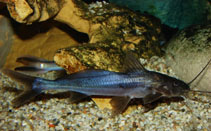| Family: |
Pimelodidae (Long-whiskered catfishes) |
| Max. size: |
20 cm SL (male/unsexed) |
| Environment: |
demersal; freshwater; depth range 20 - 30 m |
| Distribution: |
South America: Amazon and Orinoco River basins. |
| Diagnosis: |
Dorsal spines (total): 2-2; Dorsal soft rays (total): 6-6; Anal soft rays: 11-14; Vertebrae: 46-50. Distinguished by having 2-3 rows of heavy, firmly attached conical teeth on premaxillae and dentaries; lacrimal (= infraorbital 1+2) shaped as an obtuse-angled triangle with nearly straight sides; relatively long, nearly straight-margined adipose fin (its length 2.0-2.5 in SL); short dorsal fin spine, low dorsal fin (spine length 5.6-8.6 in SL); relatively small head (head length 4.0-5.2 times in SL); small eye (horizontal diameter 3.4-5.5 times in snout length, 7.4-12.0 times in head length); neural spines of vertebrae 13 or 14 - 23 or 24 oriented 90°to horizontal axis of centra; supraoccipital process with a narrow median keel above somewhat concave sides, markedly angular in cross-section, slender and tapering to its peg-and-socket joint with supraneural (basal width of supraoccipital process about 2 times in length); anterior anal-fin rays broad, forming a paddle-like blade; posterior nostril ovoid, its long axis oriented transversely (Ref. 57763). |
| Biology: |
|
| IUCN Red List Status: |
Least Concern (LC); Date assessed: 21 December 2020 Ref. (130435)
|
| Threat to humans: |
harmless |
Source and more info: www.fishbase.org. For personal, classroom, and other internal use only. Not for publication.
